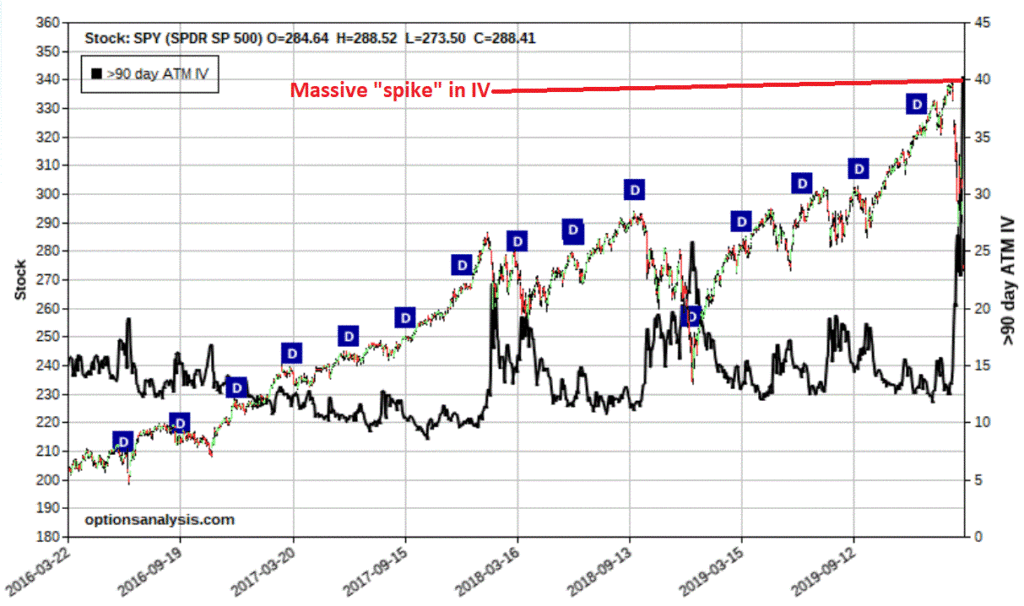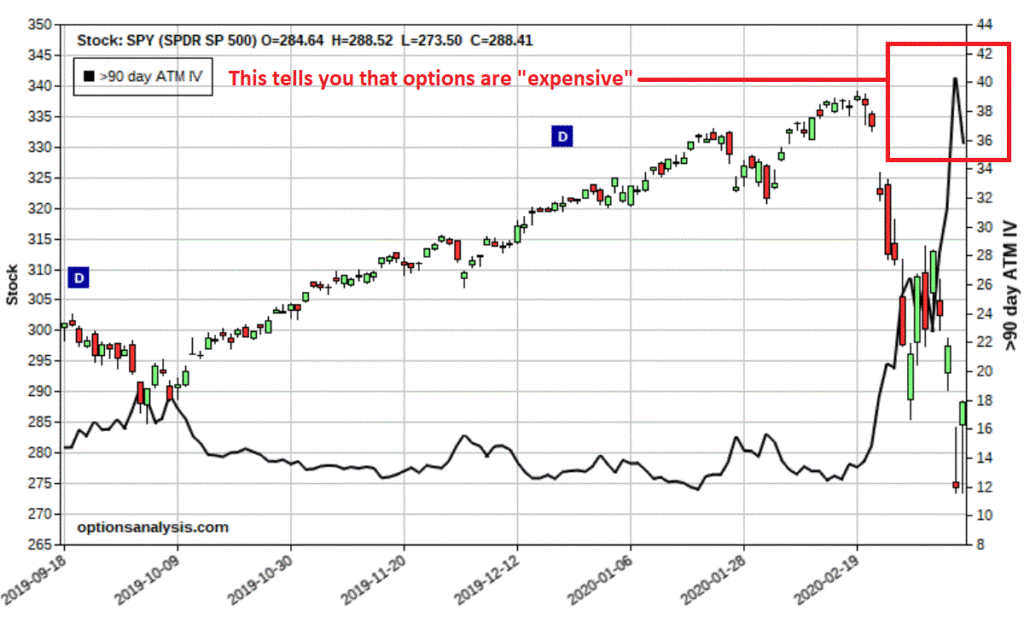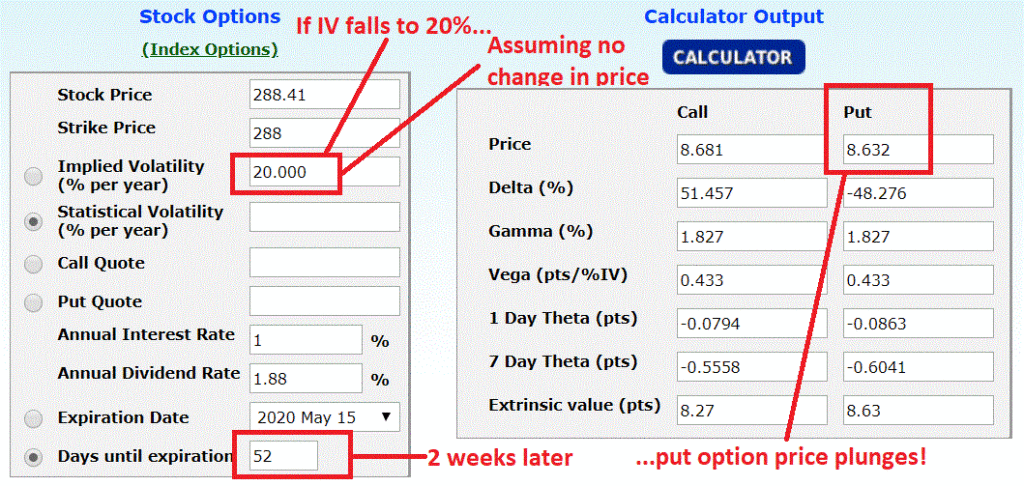The reality is that there are many terrific opportunities available to option traders at the moment. Unfortunately, there are mostly NOT the kind that the majority of individual traders are used to – or should necessarily be pursuing.
There are two areas of concern:
*Astronomically high implied volatility (more on this in a moment)
*Excessively large bid/ask spreads
A quick and dirty way to understand implied volatility:
*An option trading “in-the-money” its price is comprised of “intrinsic value” (i.e., the amount be which it is in-the-money) and “extrinsic value”, more commonly known as “time premium.”
*An option trading “out-of-the-money is comprised solely of time premium.
*Think of time premium as the amount that the option buyer pays the option write in order to induce the option writer to assume the risk of selling the option in the first place.
*The best analogy is the “insurance premium” one. You pay a premium to an insurance company in order to induce them to write you an insurance policy. Likewise, you pay (time) premium to an option writer in order to induce them to write an option that you can buy.
*Now let’s look at it from the perspective of the option writer. If the market is calm and quiet and there just isn’t much going on you will still demand a certain price from the option buyer before you will assume the risk of writing an option.
*OK, now if the market and/or the specific security you are trading is wildly volatile with large price swings, are you going to demand more time premium or less in order to assume the risk of writing an option? The question answers itself.
*So, when things get crazy – and as demand from panicked option buyers increases, option premiums can increase significantly. The way to identify whether this volatility is high, low or somewhere in between is to look at the implied volatility for the options on that stock.
*If IV is exceedingly low that means that options are “cheap”, i.e., time premiums are low (this can be a good time to buy premium)
*If IV is exceedingly high that means that options are “expensive”, i.e., time premiums are high (this can be a good time to sell premium for traders who are so inclined)
IMPORTANT POINT: If you are thinking that because of the large price movements that you will buy a call or put option and making a killing – well, you may be able to if the underlying security moves far enough in price, BUT:
*You will be paying an extremely high price for the privilege of buying that option (repeating now, if implied volatility is extremely high – which it is – you will be paying a lot of time premium)
*In addition, if IV subsides while you hold that long call or put, time premium may collapse, thereby sharply decreasing the value of your option.
To put things in perspective, the IV for options on ticker SPY (an ETF that tracks the S&P 500 Index) over roughly four years is displayed as the black line in Figure 1.

Figure 1 – SPY with Implied Volatility (IV) “to the moon” (Courtesy www.OptionsAnalysis.com)
Figure 2 zooms in on the most recent 120 days in Figure 1.

Figure 2 – SPY with IV (Courtesy www.OptionsAnalysis.com)
Notice the huge spike in IV – the black line? This is your warning that time premium levels are “crazy” high. Let’s look at what this means to a trader.
Let’s say you expect SPY to resume its recent decline, between now and May options expiration. You might buy the May 288 put @ $20.11 (cost – $2,011). The current IV for this option is 41.26. See Figure 3.

Figure 3 – SPY May 288 put: Cost = $20.11, Implied Volatility = 41.26% (Courtesy www.OptionsAnalysis.com)
Figure 4 displays the current status of the SPY May 288 put, i.e.,
*SPY trading at 288.41
*The option trading at $20.11
*Implied Volatility is 41.26

Figure 4 – Current status of SPY May 288 put (Courtesy www.OptionsAnalysis.com)
The All-Important Effect of Changes in Implied Volatility
Now let’s get down to the nitty gritty that really matters.
First, take another look at Figure 1 and note that “typically” following “spikes” in IV:
*The market “tends” to rebound, AND
*IV tend to decline sharply
So here is a though experiment. Let’s say:
*SPY is exactly unchanged 2 weeks from now AND
*IV has fallen 50% back into the “normal” 20% range
In the left-hand side of Figure 5, the only numbers that have changed are:
*Implied Volatility is down to 20% (from 41.62%)
*Days until expiration is down from 66 to 52

Figure 5 – SPY May 288 put AFTER IV declines ;(Courtesy www.OptionsAnalysis.com)
Note the change to the price of the put option: It fell from $20.11 to just $8.63! This is typically referred to as a “volatility crush.”
This is with NO CHANGE IN PRICE – SPY is at the same price it was 2 weeks ago, and yet solely because the market – and investor’s fears – have “calmed down”, this option – in theory – could lose -57% in value.
IMPORTANT POINT:
None of this means that you cannot make money by buying a put option (for the record, if SPY fell 10% in price in two weeks with no change in IV, the May 288 put would be worth roughly $34 per contract, a 69% gain). But here is the point:
*Long-term success in option trading comes from putting the odds as much on your side as possible on a trade-by-trade basis.
*Buying options when implied volatility levels are at extremely high levels DOES NOT constitute putting the odds on your side.
If you are a trader who typically just buys calls and puts, you might consider either scaling back a bit – or um, self-quarantining completely – for a little while until IV’s come back to earth.
Jay Kaeppel
Disclaimer: The information, opinions and ideas expressed herein are for informational and educational purposes only and are based on research conducted and presented solely by the author. The information presented does not represent the views of the author only and does not constitute a complete description of any investment service. In addition, nothing presented herein should be construed as investment advice, as an advertisement or offering of investment advisory services, or as an offer to sell or a solicitation to buy any security. The data presented herein were obtained from various third-party sources. While the data is believed to be reliable, no representation is made as to, and no responsibility, warranty or liability is accepted for the accuracy or completeness of such information. International investments are subject to additional risks such as currency fluctuations, political instability and the potential for illiquid markets. Past performance is no guarantee of future results. There is risk of loss in all trading. Back tested performance does not represent actual performance and should not be interpreted as an indication of such performance. Also, back tested performance results have certain inherent limitations and differs from actual performance because it is achieved with the benefit of hindsight.


Thanks for the most lucid write-up on implications for high IV… Interestingly I go long on OTM Options – Strangle… when IV is high! I always make money that ways… Theta effect is least when you square your position in 2-3 days.
Thanks , most lucid article on IV and it’s implications.